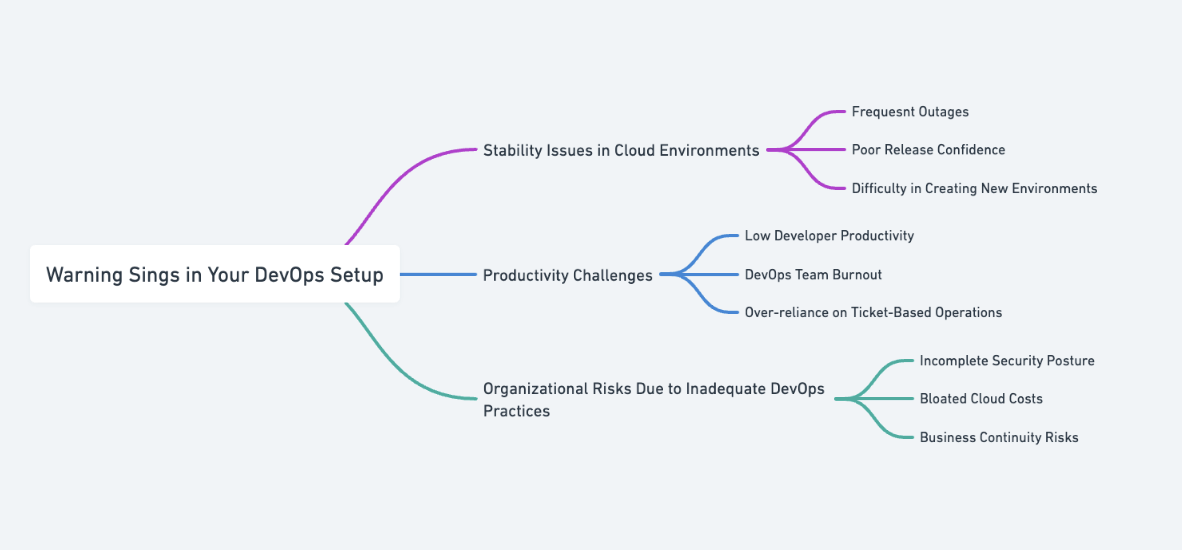Stop firefighting with your DevOps Implementation. Here’s a 10-point checklist to make sure.
Contents
-
Warning signs to gauge the completeness of your DevOps setup
-
What to Keep in Mind While Streamlining your DevOps Implementation?
In the course of building out Facets, we’ve talked to over 300 organizations, and very few can say they have fully streamlined DevOps processes. How does your organization compare? Are your planned stories being overshadowed by an ever-growing backlog filled with urgent, unplanned stories?
The challenge with DevOps is that often, systematic issues aren't obvious until they start negatively affecting your software delivery.
Warning signs to gauge the completeness of your DevOps setup

1. Stability Issues in Cloud Environments
- Frequent Outages: Regular SLA breaches often stem from misconfigurations in the cloud environment, indicating a need for more thorough automation in the CI/CD pipeline.
- Poor Release Confidence: Excessive manual interventions to ensure stability suggest underlying inconsistencies in the deployment process.
- Difficulty in Creating New Environments: Challenges in launching new environments point to a lack of centralized knowledge and documentation, increasing the risk of issues in production.
2. Productivity Challenges
- Low Developer Productivity: Frequent blocks during collaboration with DevOps teams, such as during code releases or configuration changes, indicate productivity issues.
- DevOps Team Burnout: High pressure and the need for constant adaptation can lead to burnout, affecting both individual well-being and organizational efficiency.
- Over-Reliance on Ticket-Based Operations: Excessive dependency on ticket systems for communication between developers and DevOps teams can cause delays and bottlenecks in the SDLC.
3. Organizational Risks Due to Inadequate DevOps Practices
- Incomplete Security Posture: Last-minute fixes during compliance audits reveal vulnerabilities, necessitating a more robust DevOps strategy with better security mechanisms.
- Bloated Cloud Costs: Frequent cost audits indicate an incomplete approach to DevOps, highlighting the need for a design-first, cost-optimized strategy.
- Business Continuity Risks: The discrepancy between claimed and actual disaster recovery capabilities exposes organizations to significant risks, especially during cloud provider outages.
If you notice any of these signs in your organization (which I can bet, you will) your DevOps setup needs to be audited for seamless implementation. The primary goal of DevOps is to improve collaboration and communication among development and operations teams, resulting in the increase of speed and efficiency of software delivery, and an improvement in the quality and reliability of software products and services.
Since the function by definition involves collaboration across teams there are multiple aspects that need to be addressed while streamlining DevOps implementation.
What to Keep in Mind While Streamlining Your DevOps Implementation?
Here’s a 10-point checklist across multiple tenets of a successful DevOps implementation. Something that you can use as guiding principles for your organization as well.
1. Align Business Goals Across Teams: Create a unified strategy by aligning the objectives and priorities of various departments, ensuring that development, operations, and business teams work cohesively towards common goals.
2. Understand and Manage Software Lifecycle: Maintain a clear understanding of the various stages involved in software development, from inception to deployment and maintenance, and manage these stages effectively to optimize the software lifecycle.
3. Accelerate from Concept to Product: Focus on streamlining the process from initial idea generation to the delivery of a functional product, reducing the time it takes to turn concepts into usable software.
4. Continuously Improve Processes: Engage in ongoing evaluation and enhancement of work processes, employing strategies such as agile methodologies to increase efficiency, effectiveness, and adaptability in the workflow.
5. Provide Robust Development Environments: Equip developers with environments that closely mirror the actual production setting, enabling accurate testing and smoother transitions from development to production, thereby reducing deployment risks.
6. Implement Scalable Cloud Solutions and Microservices Architecture: Embrace cloud computing solutions for scalability and flexibility. Adopt a microservices architecture to break down the application into smaller, independently deployable services, each running in its own process and communicating with lightweight mechanisms. This approach allows for easier scalability, quicker deployment, and more effective fault isolation.
7. Integrate Automated Testing and Continuous Integration/Delivery: Incorporate automated testing into the development process for consistent and reliable results; utilize continuous integration (CI) to merge code changes regularly, and continuous delivery (CD) to automate the deployment process, ensuring that software is always in a release-ready state.
8. Emphasize Monitoring and System Health: Implement comprehensive monitoring tools to continuously track system health, performance, and potential issues, enabling proactive identification and resolution of problems.
9. Adopt Infrastructure-as-Code and Containerization: Manage and provision infrastructure using code for consistent, repeatable environments, and leverage container technology for efficient, scalable, and isolated application deployment.
10. Document, Track, and Manage Systematically: Maintain detailed documentation of all operational procedures, changes, and configurations. Utilize a change management system to systematically track and audit modifications across the DevOps process. Employ checklists to ensure thorough process adherence and consistency, aiding in maintaining high standards of quality and reliability.
So, how do you stack up?
A thorough audit of your DevOps setup is crucial if you identify any warning signs of inefficiency or instability. The checklist offers a strategic framework to enhance collaboration, streamline processes, and improve software delivery.
By implementing these principles, you can achieve more efficient, reliable, and high-quality software development, overcoming common obstacles in DevOps practices. The approach not only addresses technical aspects but also encourages a culture of continuous improvement and cross-functional teamwork.
Here’s to better implemented DevOps, all across!